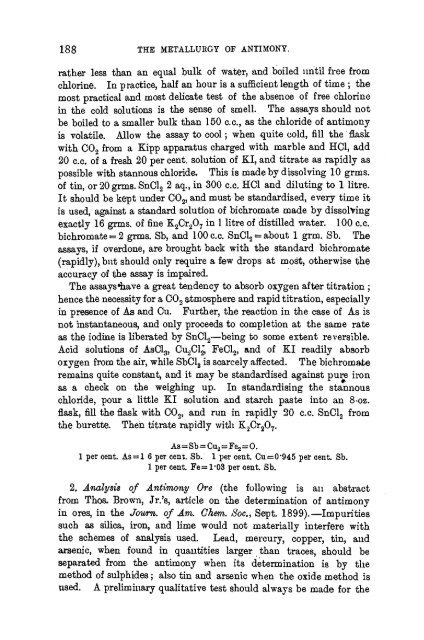antimony - Sciencemadness.org
antimony - Sciencemadness.org
antimony - Sciencemadness.org
Create successful ePaper yourself
Turn your PDF publications into a flip-book with our unique Google optimized e-Paper software.
188 THE METALLURGY OF ANTIMONY.<br />
rather less than an equal bulk of water, and boiled until free from<br />
chlorine. In practice, half an hour is a sufficient length of time ; the<br />
most practical and most delicate test of the absence of free chlorine<br />
in the cold solutions is the sense of smell. The assays should not<br />
be boiled to a smaller bulk than 150 c.c, as the chloride of <strong>antimony</strong><br />
is volatile. Allow the assay to cool; when quite cold, fill the" flask<br />
with CO2 from a Kipp apparatus charged with marble and HC1, add<br />
20 c.c. of a fresh 20 per cent, solution of KI, and titrate as rapidly as<br />
possible with stannous chloride. This is made by dissolving 10 grms.<br />
of tin, or 20 grms. SnCl2 2 aq., in 300 c.c. HC1 and diluting to 1 litre.<br />
It should be kept under CO2, and must be standardised, every time it<br />
is used, against a standard solution of bichromate made by dissolving<br />
exactly 16 grms. of fine K2Cr.2O7 in 1 litre of distilled water. 100 c.c.<br />
bichromate « 2 grms. Sb, and 100 c.c. SnCl2 = about 1 grm. Sb. The<br />
assays, if overdone, are brought back with the standard bichromate<br />
(rapidly), but should only require a few drops at most, otherwise the<br />
accuracy of the assay is impaired.<br />
The assays •have a great tendency to absorb oxygen after titration ;<br />
hence the necessity for a CO2 atmosphere and rapid titration, especially<br />
in presence of As and Cu. Further, the reaction in the case of As is<br />
not instantaneous, and only proceeds to completion at the same rate<br />
as the iodine is liberated by SnCl2—being to some extent reversible.<br />
Acid solutions of AsCl3, Cu2Cl2, FeCl2, and of KI readily absorb<br />
oxygen from the air, while SbCl3 is scarcely affected. The bichromate<br />
remains quite constant, and it may be standardised against pure iron<br />
as a check on the weighing up. In standardising the stannous<br />
chloride, pour a little KI solution and starch paste into an 8-oz.<br />
flask, fill the flask with CO2, and run in rapidly 20 c.c. SnCl2 from<br />
the burette. Then titrate rapidly with K2Cr207.<br />
As=Sb = Cu2 = Fe2=O.<br />
1 per cent. As = l 6 per cent. Sb. 1 per cent. Cu=0*945 per cent. Sb.<br />
1 per cent Fe = l*03 per cent. Sb.<br />
2. Analysis of Antimony Ore (the following is an abstract<br />
from Thos. Brown, Jr.'s, article on the determination of <strong>antimony</strong><br />
in ores, in the Jowrn. of Am. Chem. Soc, Sept. 1899).—Impurities<br />
such as silica, iron, and lime would not materially interfere with<br />
the schemes of analysis used. Lead, mercury, copper, tin, and<br />
arsenic, when found in quantities larger than traces, should be<br />
separated from the <strong>antimony</strong> when its determination is by the<br />
method of sulphides; also tin and arsenic when the oxide method is<br />
used. A preliminary qualitative test should always be made for the
















